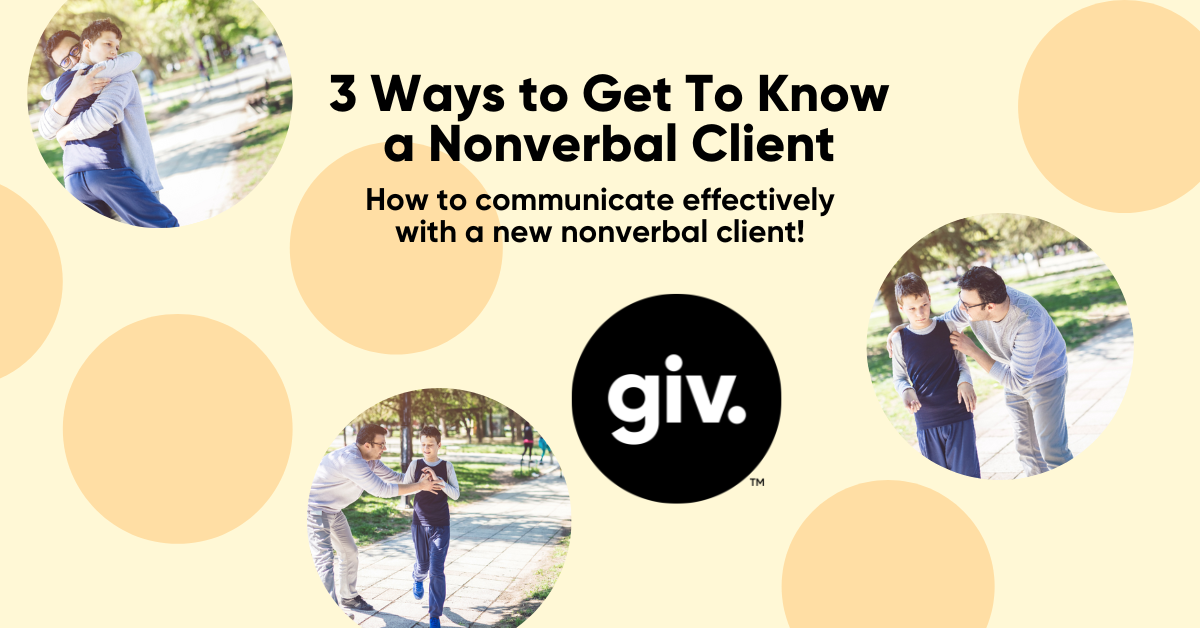If you’re wondering how to communicate with nonverbal clients, here are three great way to communicate with them more effectively. It is common in caregiving to have clients who are nonverbal, so these will help you build strong relationships with those clients.

What Does it Mean to be Nonverbal?
Before we dive into interacting with someone who is nonverbal, we first need to take a look at what this actually means. If someone is nonverbal, this means that they don’t rely on speech for their primary means of communication. This does not mean that the person cannot speak any words at all. They might have a few key words they use to communicate from time-to-time, but the majority of their communication is not through spoken words. These individuals still can produce sounds verbally as well. In fact, they might grunt or make other noises on a regular basis. These sounds that they make can often times give a caregiver cues as to wether they’re feeling happy, sad, scared etc… so be on the lookout for those sounds and try to determine what they’re trying to communicate.

Examples of Nonverbal Communication:
People who do not communicate primarily through speech may rely on other forms of communication when interacting with others. There are many different ways some individuals might learn to communicate, but some of the most common ones are:
- Sign Language
- The person may know many signs, or just a small handful of signs for basic words and phrases.
- Augmentative or Alternative Communication (AAC Device)
- Most commonly used with a picture system on a tablet where the person points to the pictures to communicate wants and needs.
- Eye Gaze
- The person can move their eyes one direction or another to answer yes or no questions, or questions with two possible options. Someone trying to communicate with someone who uses this type of communication could hold two pictures in the air, and whichever picture the individual gazes at would be the option they’re trying to select.
- Body Language
- Does the person look happy? Do they look uncomfortable? What is their body trying to tell you?

How to Communicate with Nonverbal Clients:
Now that we know what it means to be nonverbal, and the different ways nonverbal people communicate, how do we get to know these individuals when we first meet them?
Observe First:
You might want to jump right in an introduce yourself, and start working on whatever they’re doing, but the best thing to do is to step-back and watch for a minute and take an inventory of what they’re doing.
What is their body saying? Do they look happy, sad, scared? Get a good read on how they might be feeling before jumping in and trying to be their new friend.
It will also be helpful before you start acting as a caregiver to get as much information about their likes and dislikes from their primary caregiver as possible. This helps you have as much information as possible before jumping into the situation, and you know some key topics/likes/dislikes of the individual so you can find some common ground.
Speak To Them Using Simple Language:
Once you’ve taken inventory of how they might be feeling, jump in and introduce yourself if you think they’re feeling up to meeting someone new. It’s important to keep in mind that people who are nonverbal may also take a bit longer to process what you’re saying, so using more simple words/sentences is best, and give them some extra time to process and respond.
Instead of saying, “Hi, my name is Sarah, I really like the blue and white stripes on your shirt! Can I see what you’re playing with?”, try “Hi, I’m Sarah!” After they’ve had time to take in that information, you can move toward, “Do you like puzzles?”, “Can I play too?”, or some other small phrase to help make a connection and foster interaction.
It is important to speak to them in a normal tone of voice. You may be tempted to speak louder, slower, or even in a coddling voice. These can all come across as patronizing, even if your intentions are good. It’s important to speak to them directly, just as you would with anyone else.
Ask Close Ended Questions:
If you’re asking questions to gather information from your client, it is best to ask in simple close-ended questions that require simple yes or no answers. This gives them the opportunity to take in the information and respond in ways that work for them either with a simple nod of their head, eye gaze, or pointing to a picture/word on a paper to get their answer across.
If you’re trying to determine if the individual wants milk or juice to drink, don’t ask, “Do you want milk or juice?” Ask, “Do you want milk?” if they communicate no, then ask, “Do you want juice?”. Breaking the question down into smaller and simpler parts will make communication between the two of you much easier since yes or no questions are much easier to answer than ones that require a more specific word or phrase.
These are some of our best suggestions for caregivers when they’re starting to work with a client who is nonverbal. If there are other suggestions you have, we would love to hear them in the comments!






